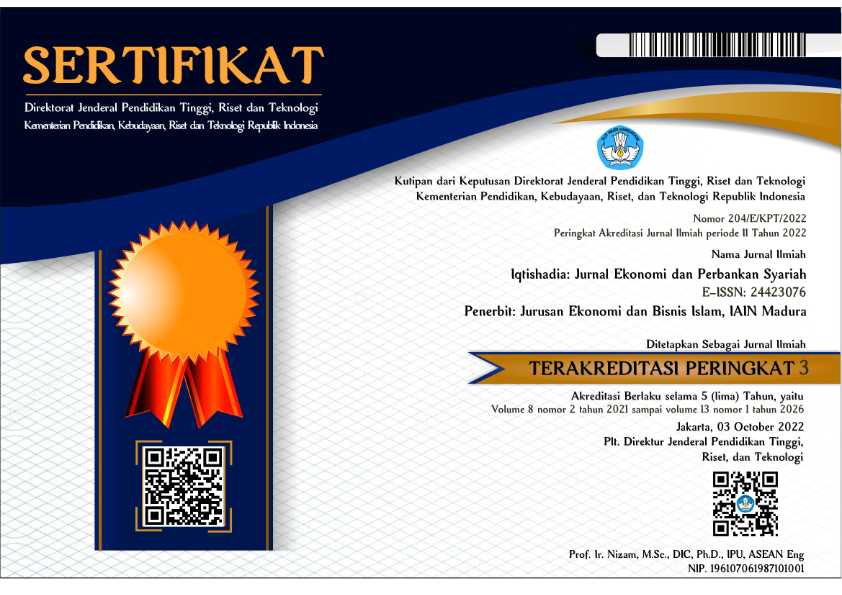Analisis Tingkat Kemiskinan Kaum Urban Berdasarkan Indeks Cibest di Kecamatan Kepil Kabupaten Wonosobo
 Abstract views: 661
,
Abstract views: 661
,
 PDF downloads: 438
PDF downloads: 438
Abstract
Downloads
References
Badan Pusat Statistik Kabupaten Wonosobo. Kabupaten Wonosobo dalam Angka 2017. Wonosobo: BPS. 2017.
Hasan, Mohammad. “DAKWAH DAN PROBLEMA KEMISKINAN.” IQTISHADIA: Jurnal Ekonomi & Perbankan Syariah 1, no. 1 (28 November 2014): 15. https://doi.org/10.19105/iqtishadia.v1i1.363.
Irfan Syauqi Beik dan Laily Dwi Arsyianti, Ekonomi Pembangunan Syariah. Jakarta: RajaGrafindo Persada. 2016.
Isna, Alizar dan Warto. Analisis Data Kuantitatif Dengan IBM SPSS Statistics 20: Panduan Praktis untuk Penelitian Sosial Dilengkapi dengan Analisis Regresi Nominal dan Ordinal. Purwokerto: STAIN Press. 2013.
Karim, Adiwarman A. Ekonomi Mikro Islami. Jakarta: Rajawali Press. 2010.
Peraturan Menteri Tenaga Kerja dan Transmigrasi Republik Indonesia Nomor PER. 07/ MEN/ IV/ 2008 tentang Penempatan Tenaga Kerja.
Putong, Iskandar. Economics: Pengantar Mikro Makro. Jakarta: Mitra Wacana Media. 2013.
Sugiyono, Metode Penelitian Pendidikan: Pendekatan Kuantitatif, Kualitatif dan R&D. Bandung: Alfabeta. 2009.
Tambunan, Tulus T. H. Perekonomian Indonesia: Teori dan Temuan Empiris. Jakarta: Ghalia Indonesia. 2001.
Thalib, Hamidy, M. Irwan, dan Ihsan Ro’is. “Peranan Amil sebagai Pengelola Zakat untuk Kesejahteraan Umat di Kota Bima.” IQTISHADIA: Jurnal Ekonomi & Perbankan Syariah 3, no. 2 (20 Desember 2016): 290–206. https://doi.org/10.19105/iqtishadia.v3i2.1079.
Yaqin, Ainol. “OPTIMALISASI ZAKAT PRODUKTIF DALAM PENGENTASAN PROBLEM KEMISKINAN.” IQTISHADIA: Jurnal Ekonomi & Perbankan Syariah 2, no. 2 (31 Desember 2015): 220–41. https://doi.org/10.19105/iqtishadia.v2i2.849.
The journal operates an Open Access policy under a Creative Commons Non-Commercial Share-Alike license. All articles published Open Access will be immediately and permanently free for everyone to read and download.
• Creative Commons Attribution-NonCommercial (CC-BY-NC)

Iqtishadia: Jurnal Ekonomi dan Perbankan Syariah by http://ejournal.iainmadura.ac.id/index.php/iqtishadia is licensed under a Creative Commons Attribution-NonCommercial 4.0 International License.
Based on a work at http://ejournal.iainmadura.ac.id.


























